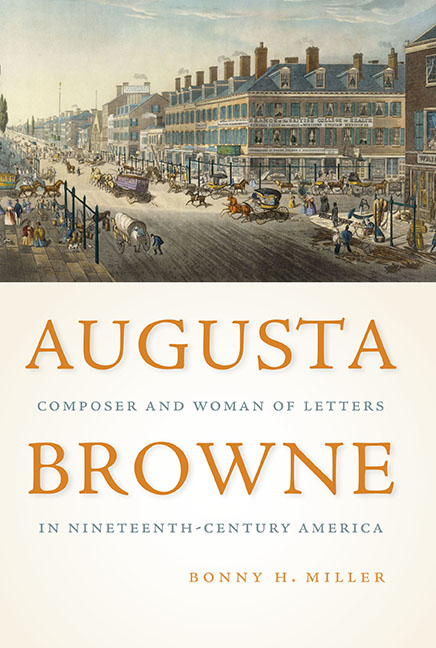Book contents
- Frontmatter
- Contents
- List of Illustrations
- Preface
- Acknowledgments
- Introduction
- 1 First Steps
- 2 Apprentice in a Family Music Business
- 3 Philadelphia Debut
- 4 A Young Professor of Music
- 5 A New Leaf
- 6 Her Own Woman
- 7 Courtship and Consequences
- 8 Pilgrim in Progress
- 9 “Glad Fruition”
- 10 Legacy in Music
- 11 Legacy in Literature
- 12 Contributions to Music Journalism
- 13 A Legacy Written into History
- Appendixes
- Appendixe 1 Children and Descendants of David Samuel Browne and Elizabeth Montgomery Browne
- Appendixe 2 Chronology of Augusta Browne’s Music and Letters
- Appendixe 3 List of Musical Works
- Appendix 4 Selected Glossary
- List of Abbreviations
- Notes
- Selected Bibliography
- Index
- Frontmatter
- Contents
- List of Illustrations
- Preface
- Acknowledgments
- Introduction
- 1 First Steps
- 2 Apprentice in a Family Music Business
- 3 Philadelphia Debut
- 4 A Young Professor of Music
- 5 A New Leaf
- 6 Her Own Woman
- 7 Courtship and Consequences
- 8 Pilgrim in Progress
- 9 “Glad Fruition”
- 10 Legacy in Music
- 11 Legacy in Literature
- 12 Contributions to Music Journalism
- 13 A Legacy Written into History
- Appendixes
- Appendixe 1 Children and Descendants of David Samuel Browne and Elizabeth Montgomery Browne
- Appendixe 2 Chronology of Augusta Browne’s Music and Letters
- Appendixe 3 List of Musical Works
- Appendix 4 Selected Glossary
- List of Abbreviations
- Notes
- Selected Bibliography
- Index
Summary
The family was still mourning David Browne's death when the dwindling group of mother, daughter, son, and housekeeper relocated to Washington, DC. William Henry Browne accepted an appointment as an examiner of land conveyances and mechanical engineering at the US Patent Office in 1868. He was among a wave of men and women who came to live and work in the capital following the war years, when the distressed city had become shabby. The District of Columbia needed to enlarge to accommodate these recently employed civil servants during the Republican administration of President Ulysses S. Grant. Forceful methods by the civic leader Alexander “Boss” Shepherd resulted in the filling of the Washington Canal, the paving of city streets, and improved infrastructure. Iconic government buildings, such as the dome and extensions of the Capitol Building, were completed or expanded.
The Patent Office occupied a square city block at 8th and F Streets, NW. The architectural design in imposing Greek Revival style signified a temple to American invention, ingenuity, and industry. Construction of the enormous space—currently occupied by the Smithsonian American Art Museum and the National Portrait Gallery—lasted more than thirty years before completion in 1866. Meanwhile, enhanced amenities for urban living included new residential neighborhoods with sidewalks, gas street lamps, parks, and squares. Washington quickly bred a fashionable, well-heeled upper class as money flowed freely during Reconstruction.
During the Easter season in 1871, Augusta's name appeared as organist and choir director at Trinity Protestant Episcopal Church, located at 3rd and C Streets. William Henry was listed as a second bass in the small vocal ensemble that sang the special music at the Easter morning service. A dramatic 1862 photograph of the church “topped by airy, open steeples made of wood” shows the impressive church designed by James Renwick—better known for his distinctive red sandstone Smithsonian Castle building—with the unfinished dome of the Capitol as a backdrop (see fig. 9.1). This music position must have been a prize to Augusta. Not only was Trinity a leading church among the city's white-collar workers but it also lay within a block or two of her address at 422 3rd St., NW.
- Type
- Chapter
- Information
- Augusta BrowneComposer and Woman of Letters in Nineteenth-Century America, pp. 185 - 213Publisher: Boydell & BrewerPrint publication year: 2020



